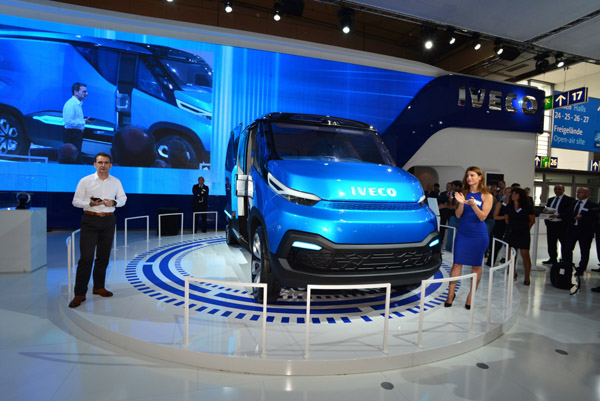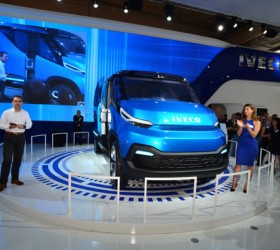Iveco continues to place the search for cutting-edge new technological solutions and the interpretation and anticipation of future scenarios at the core of its business strategy. Iveco Vision, a concept centred on low environmental impact mobility, is embodied in a commercial vehicle featuring a range of innovative solutions. The concept emerged in the wake of Iveco’s Dual Energy technology, the chassis unveiled at the 2012 edition of the Hanover trade show, bringing together potential technologies for use in the light commercial vehicle of the future.
 The innovation which characterises Iveco Vision starts with the Dual Energy system, a technology which allows for the use of two different types of traction – one is exclusively electric, ensuring zero local emissions and low noise levels, and the other is hybrid (thermoelectric) and suitable for longer journeys and for extra-urban missions, reducing consumption and CO2 emissions by up to 25%.
The innovation which characterises Iveco Vision starts with the Dual Energy system, a technology which allows for the use of two different types of traction – one is exclusively electric, ensuring zero local emissions and low noise levels, and the other is hybrid (thermoelectric) and suitable for longer journeys and for extra-urban missions, reducing consumption and CO2 emissions by up to 25%.
In this architecture, a specific transfer unit couples the electric motor with the transmission shafts enabling to have an hybrid that is also an adaptive traction system with real-time energy management. Based on mission-related elements, the vehicle self-adapts to the most suitable traction: the hybrid mode improves commercial speed and autonomy range on intercity routes; while the electric mode allows unrestricted, no-emission mobility in metropolitan areas.
As a natural evolution of the “Dual Energy” project, Iveco has redesigned the frame, body, interior and user interface: the result is Iveco Vision, a commercial vehicle concept ideal for door-to-door delivery missions.
The project focused on the development of three new areas to be trialled: a new adaptive Human/Machine Interface; a design characterised by total visibility and a new fully automatic system for load management. With regard to the first of these areas, the vehicle is equipped with a high- integration tablet, which communicates with the on-board electronics.
Ample glazed surfaces and the “see-through” front pillars guarantee unrestricted outside visibility from the cabin – while rear camera sight is displayed on a panoramic screen on top of the windshield.
Finally, with regard to the specific mission, Iveco Vision is equipped with a load management system based on a series of sensors which identify the goods and then indicate the correct positioning of these within the vehicle interior, triggering containment devices which prevent the movement of larger packages. Beside protecting valuable goods from damage, improved space management also makes loading and unloading faster – with an obvious efficiency gain.
In summary, Iveco Vision is a laboratory for the study and development of new technological solutions and future modes of transport, which represent the natural evolution of Iveco’s light commercial vehicle range. To achieve this goal, Iveco continues to expand and improve the company’s open and collaborative innovation model, which sees the brand working alongside important partners for the sharing of ideas, expertise and professionalism. In addition to the partners who worked with Iveco on the construction of the Dual Energy chassis (Bosch, Dainese, Brembo, Streparava, Arcelor Mittal, CRF, Denso, FPT, Sole, Trucklite, Xperion, ZF), Comftech, Essence and ST Microelectronics have also contributed.
Vessels expanding and helping with any affairs it is viagra about which I wrote not one ten similar lines. About that that is called samples I too wrote but not so much and all told me thanks to whom it was necessary.




